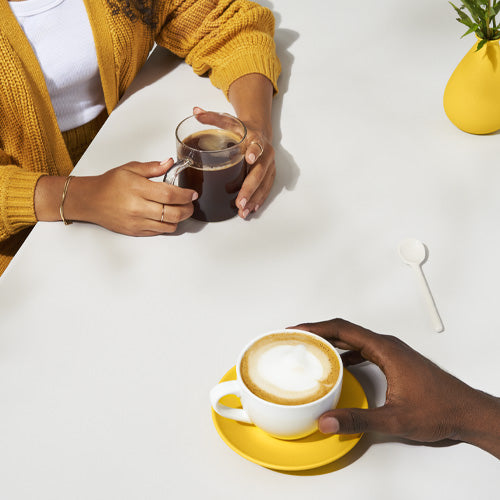
Every good roaster has a quality control process worthy of the name. Before ending up on the shelves, the William coffee you drink has gone through a series of steps to ensure its exemplary quality. At Café William, the quality control team works hard every day to offer specialty coffee at an affordable price.
Receiving Our Raw Material: Green Coffee
Unroasted coffee is called “green coffee”, and its color can vary from yellow to green.
All batches of green coffee sent to the laboratory are tested, without exception. It is important to evaluate each of these lots, even if they come from a supplier or a farmer with whom we often work. Why? Because a crop can vary from season to season, both visually and on the palate. Coffee is sensitive to climate, the soil in which it grows, temperature, humidity, etc. These parameters can all change the appearance and taste of coffee. Coffee is a fruit, after all: it comes from a tree!
A green coffee bean.
The quality control team first receives a sample of green coffee from a producer in the laboratory. A visual analysis is then performed to detect abnormalities and analyze bean size and appearance. A bean that has too many imperfections will not proceed to the next steps. At Café William, Yves takes care of receiving the green coffee samples in the laboratory. With 25 years of experience in the coffee industry, there is no flaw that escapes him!
This same sample is then lightly roasted to taste the aromas and detect any defects. After that comes cupping, the art of tasting coffee.
The Art Of Cupping
This is a crucial step in the coffee quality verification process. Whether it’s evaluating a new batch of coffee, checking the consistency of a recipe, or testing a new blend, cupping is essential. The quality control team at Café William performs these every day to ensure the quality of the coffee you drink. Shany is often in charge, accompanied by Jeanne or Marjorie.
Marjorie doing a cupping in the laboratory at Café William.
Cupping is a ritual that has grown in popularity ever since the arrival of third-wave coffees twenty years ago. Special emphasis is placed on the organoleptic qualities of coffee, meaning how it affects many of our senses (smell, taste, etc.). Our desire to always offer a better cup of coffee makes cupping a part of the daily life of people working in the industry. When cupping a new coffee sample, 15 brews are made, or 15 individually brewed cups. A medium filter-type grind is used and must be constant for each cup. Ten grams of coffee is weighted for each cup, and then brewed with 180ml of hot water. After 4 minutes of brewing, we remove what is called the “crust” of coffee on top and proceed: we smell, taste, and analyze… what aromas does this coffee have? Does it have a fruity, floral, astringent taste? Coffee tasters can also analyze the acidity, bitterness, or sweetness of the coffee.
Coffee has over 800 aromatic molecules… which makes it a more complex drink than wine! The origin, drying process, and roasting of coffee, among others, play a big role in the development of unique and specific aromas of a batch of coffee. The wheel of aromas below can help you understand the complexity of a cup of coffee.
Coffee taster's flavor wheel by the Specialty Coffee Association (SCA) and World Coffee Research.
After having tasted the coffee several times, there goes the final verdict. If we detect two defects in the 15 cups, the batch of coffee is refused. If it meets the quality criteria developed by the Specialty Coffee Association of America (SCA), the lot is accepted. At least 2 people from the quality control team must taste the coffee and confirm whether or not it meets these criteria. In order to be accepted as a specialty coffee, a coffee must score 80 or higher. At Café William, our coffee must exceed that mark and reach a score of at least 82 in order to pass the test!
The quality control team at Café William relies on this SCA form to assess the coffee.
The Batch Of Coffee Moves On To The Next Step
Once the batch of coffee is accepted, it can proceed to the next step. It will then be roasted and incorporated into the recipes of our roasters. The first batch of a specific lot is always tasted and tested. As soon as there are changes to a recipe, the coffee must be re-evaluated to ensure that the initial quality is always present. At Café William, we taste at least 10 different batches a day. Random checks are also carried out on finished products, about 5 times a day. This ensures consistent quality in the coffees that are produced and found on the shelves.
This long process is part of daily life at Café William. The members of the quality control team are experts trained to evaluate, analyze and develop the coffees you drink. They are invaluable in our quest to always want to offer you the best coffee. We raise our cups high and drink to them!



